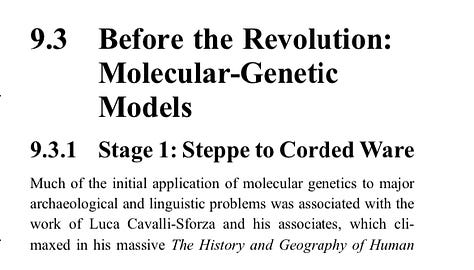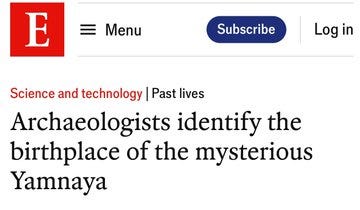Archæogenetic and Isotopic Revolutions
Finding Manuland XVIII

We notice how certain sounds and meanings are identical across the area between Ireland and India. We remark how over a period of at least three millennia (for which we have written textual sources) certain sounds and meanings maintain consistency.
We look into how this might have happened. And we discover that since 1783 many scientists and researchers have demonstrated our languages, myths, religions and cultural tropes emanate from a common source.
Therefore, we do not need to resort to explanations about magic or coincidence or innateness, when we’re trying to understand why M-N- and Rg / Rt / Reg / Rch / Rit / Rd sounds infuse almost every sentence we speak.
Finding Manuland gives us the knowledge and tools to understand the truth about our past. We can then out-manoeuvre those who seek to use myths about myths to motivate others to kill in the name of lies.
This is what’s at stake.
In 2015 the world’s preeminent scientific journal published an analysis by many scientists of ancient DNA (aDNA) evidence found inside burial mounds from Ukraine westwards as far as the island of Britain. This is the beginning of what is referred to in the literature now as the aDNA revolution.



Nature’s conclusion1 was that it was the Yamnaya who first spoke an Indo-European language.
In 2019 the journal Science published research2 co-authored by over one hundred of the world’s foremost experts in these matters that looked at ancient DNA from burial mounds east of Ukraine as far as the Swat Valley in modern Pakistan.
Science concluded that the Yamnaya had physically spread from Ukraine westwards to Ireland and eastwards to India between 4,500BCE to 2,500BCE so that by 1,000BCE 10% of Indian male Brahmin DNA was Yamnaya, while 50% of Britons’ DNA also was Yamnaya.
Recent aDNA research confirms that around 2,500 BCE, perhaps over the course of a short time period of no more than a few centuries, 90% of male DNA on the island of Britain suddenly gained a signature of DNA from ancient Ukraine.
Now, confounding previous theories about the genetic origins of the Irish, a similar process appears to have taken place on the island of Ireland.
These successive migrations occur at the same tempo as the spread of Indo-European languages would have had to proliferate, if the similarities and differences between Indo-European language communities like Sanskrit, Armenian, Anatolian, Celtic, Greek, Germanic, Italic, Baltic and Slav Indo-European tongues could be understood as a function of evolving from a common source language.
Now, even the Economist, as a mainstream magazine, is taking an interest in these matters.
Earlier this month it reported on the findings of the analysis of isotopes in the teeth of ancient Ukrainian Yamnaya from the Yamnaya type site in Mihailaiv Oblast of south-eastern Ukraine.
These findings provide evidence that complements other archaeological, linguistic, and archaeogenetic-based arguments as to why the Yamnaya Culture originated not in the “Steppe,” “Pontic-Caspian Steppe,” “Southern Russian steppe,” but actually in Ancient Ukraine specifically, as I and others who have looked closely at the evidence had already concluded.
The Economist joining our movement to de-colonise pre-history is very welcome indeed. Since the ancient DNA revolution, it’s time we reassessed how new evidence affects assumptions promoted by Russian archaeologists that the Yamnaya Culture did not originate in Ukraine.
Last month @TimothyDSnyder changed his view on the matter, as I reported here in a previous Finding Manuland instalment:
Timothy Snyder’s Move
⚡️T Snyder’s De-Colonisation of ‘Pre-History.’ Historians like Timothy Snyder usually stick only to written sources. Now, thankfully, in this short lecture (
Professor
moved the beginnings of his history of Ukraine from the first Greek colonies along its coast around 700 BCE to the Yamnaya Culture era 2,500 BCE.Multidisciplinary scholars have known at least since 2015 that ALL Indo-European language, religions and culture from Ireland to India originated in Ancient Ukraine’s 3,500 - 2,500 BCE Yamnaya Culture era.
Soviet archaeology however managed to troll many linguists, archaeologists, archaeogeneticists, historians and Comparative Mythologists / theologians into using formulae like “Steppe Ancestry,” “Southern Russia,” or “Pontic Caspian Steppe” to describe the Ancient Ukrainian homeland of the Yamnaya Culture, who were the first people of earth to speak an Indo-European language.
This attempt to annihilate Ukraine and Ancient Ukraine in all areas of culture is unconsciously propagated every time such vague linguistic formulæ are used.
Therefore we must de-colonise the disciplines that deal with so-called “pre-history” (i.e. generally the era before written sources):
Decolonising Prehistory: Our Expanding Mental Model of ‘History’
Finding Manuland is a travelogue of physical and mental journeys through today’s Europe and Asia. It seeks out and explores monuments and phenomena in today’s culture that have a family resemblance to nominal and substantive phemomena traceable at least five or six millennia ago - the
So even The Economist is properly reporting, at least, about recent Isotope analysis of a Yamnaya Culture tooth from the Yamnaya Culture type site in Mihailov Oblast of south-eastern Ukraine.
Now, we have yet another scientific discipline’s proof that the Yamnaya lived between Ancient Ukraine’s Don Hyper (Dnieper) and Don rivers (
Ancient Ukraine’s Don-sounding Rivers, Yama, and Lords of Death
The similarity between the moniker Donn (Ireland’s pre-Christian Lord of Death) and the names of rivers which embodied Gods, Lords of Death and the passage to the afterlife across the Indo-European cultural zone may be significant. It’s a structure that is
) as their teeth were being formed.
Great to see the mainstream beginning to promote the truth about Ancient Ukraine and how its innovations are immanent in every sentence and sound we form in the Indo-European languages spoken today.
Ancient Ukrainians: First Indo-Europeans
Relatively early in my research, I read that the builders of the mound that concealed the Dnipro stone henge were from what archaeologists call the Yamnaya Culture. I had never heard of the Yamnaya before. Even the idea that archaeologists defined ancient peoples as “cultures” according to similarities and differences in the way they treated their dead …
For more on these matters see:
and
As a travelogue, among other things, Finding Manuland retraces the remnants in today’s world (monde in French) of these Yamnaya journeys across Europe.
Finding Manuland also compares these ancient migrations which took place over two millennia with the remarkably similar itineraries of the millions of modern Ukrainian women and children fleeing Russia’s further invasion of the cradle of our civilisation on February 24th, 2022.
Another aspect of this Yamnaya stuff that surprised me was I had already been in Ukraine for six years at this point and I’d never heard anything about it.
For my first three years in Ukraine, I had worked as a peace-keeping diplomat on a bridge over the Donets River in eastern Ukraine.
That river, while I was there, divided Russia-held Ukrainian territory from Ukraine government-controlled territory.
It had also been a contact zone between ancient Ukraine’s first Indo-European language speaking Yamnaya communities and the last tribes of Old Europe whose language and customs they would absorb.
Yet, I had never come across the Yamnaya, these mounds or the proofs that all Indo-European languages grew out of a language that ancient Ukrainians created.
I started working in Ukraine in February 2015 - some six months before the aforementioned Nature article was published. So perhaps it’s understandable that these matters are only now becoming more widely known.
Nobody in Ukraine seemed to know that all Indo-European languages and much of the mana inside the mythology, literature and religion of Indo-European cultures can be traced, with certainty, back to the Yamnaya in ancient Ukraine.
Of all the amazing things Ukraine and Ukrainians have to be proud of, Finding Manuland will highlight what I, a retired Irish diplomat, think is preeminent among them: the fact that the disciplines of archaeology, linguistics, archaeogenetics, isotope analysis, and my own contribution - tracing the M-N- and Rt/Rg/Rch sounds across Indo-European languages, geographies and cultures - all point to a Common Source for the most characteristic elements of Indo-European culture. And that that source is in eastern Ukraine and the Yamnaya Culture.
Continued:
Bono, Manna, and the Discovery of Our ‘Common Source’
And thus the discovery of the Indo-European family of languages and culture was announced. One balmy night in Kolkata. 2 February 1786. By William Jones, a Welsh Oxford-trained Persian expert and lawyer, in his second presidential address to the Asiatick Society which he had founded, shortly after arriving in India to be a judge.
Continued from:
Mahna, Mahna!
"Immunity" begins by Meaning "100% protection." That's what powerful "Muni" meme communicates in the universe of Indo-European sounds, words, and meanings that "Mana" is immanent within. "Immunity" then becomes decoupled from this 100% Protection Meaning
First in series:
Finding Manuland I
In October 2021 I was returning from my final vacation before my forced retirement from my beloved diplomatic posting to Ukraine.
Massive migration from the steppe was a source for Indo-European languages in Europe:
https://doi.org/10.1038/nature14317
The formation of human populations in South and Central Asia: https://doi.org/10.1126/science.aat7487
















